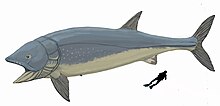
Fish vary greatly in size. The whale shark and basking shark exceed all other fish by a considerable margin in weight and length. Fish are a paraphyletic group that describes aquatic vertebrates while excluding tetrapods, and the bony fish that often represent the group are more closely related to cetaceans such as whales, than to the cartilaginous fish such as sharks and rays. [citation needed] As such, cross group comparisons on this page only serve a colloquial purpose.
Largest extant fish
[edit]| Rank | Name | Binomial name | Taxonomic class | Known maximum mass [tonnes] |
Maximum length [m (ft)] |
Images | Size comparison to human |
|---|---|---|---|---|---|---|---|
| 1 | Whale shark | Rhincodon typus | Chondrichthyes
(Cartilaginous fish) |
21.5[1] | 18.8 metres (61.7 ft)[2] | 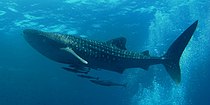 |

|
| 2 | Basking shark | Cetorhinus maximus | Chondrichthyes
(Cartilaginous fish) |
5.2 (16 unconfirmed)[1] | 14 metres (46 ft)[1][3][4] |  |

|
| 3 | Great white shark | Carcharodon carcharias | Chondrichthyes
(Cartilaginous fish) |
3.324[5] | 7 metres (23 ft)[6] |  |

|
| 4 | Tiger shark | Galeocerdo cuvier | Chondrichthyes
(Cartilaginous fish) |
3.11 (unconfirmed)[7][8] | 7.5 metres (25 ft)[9] (unconfirmed) |  |

|
| 5 | Giant oceanic manta ray | Mobula birostris | Chondrichthyes
(Cartilaginous fish) |
3.0[10] | 5 metres (16 ft)[10] |  |

|
| 6 | Giant sunfish | Mola alexandrini | Osteichthyes
(Bony fish) |
2.744[11] | 3.3 metres (11 ft)[12] | 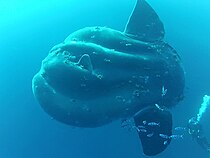 |
|
| 7 | Ocean sunfish | Mola mola | Osteichthyes
(Bony fish) |
2.3[1] | 3.1 metres (10 ft)[1] | 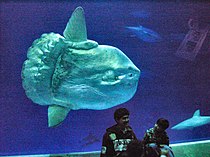 |

|
| 8 | Beluga sturgeon | Huso huso | Osteichthyes
(Bony fish) |
2.072[13] | 7.2 metres (24 ft)[14] | 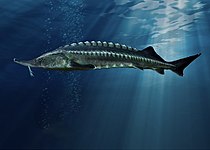 |
|
| 9 | Sharptail mola | Masturus lanceolatus | Osteichthyes
(Bony fish) |
2[15] | 3.0 metres (9.8 ft)[15] | 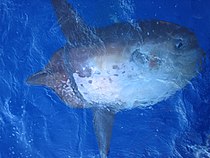 |
|
| 10 | Hoodwinker sunfish | Mola tecta | Osteichthyes
(Bony fish) |
1.87[citation needed] | 2.4 metres (7.9 ft)[citation needed] |  |
|
| 11 | Reef manta ray | Manta alfredi | Chondrichthyes
(Cartilaginous fish) |
1.4[16] | 5.5 metres (18 ft)[16] |  |
|
| 12 | Greenland shark | Somniosus microcephalus | Chondrichthyes
(Cartilaginous fish) |
1.397[1] | 7.3 metres (24 ft)[17] | 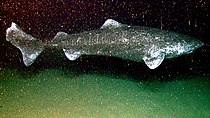 |

|
| 13 | Megamouth shark | Megachasma pelagios | Chondrichthyes
(Cartilaginous fish) |
1.215[18] | 5.2 metres (17 ft)[18] | 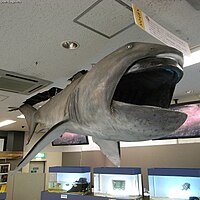 |
|
| 14 | Kaluga | Huso dauricus | Osteichthyes
(Bony fish) |
1.140[1] | 5.6 metres (18 ft)[1] |  |
Jawless fish (Agnatha)
[edit]- Hagfish (Myxini)
- The hagfish, which are not taxonomically true fish, are among the most primitive extant vertebrates. There is only one order and family in this animal class. All of the 77 known species have elongated, eel-like bodies but can be distinguished by their downward-facing mouths. The largest form is the Goliath hagfish (Eptatretus goliath). This species can range up to 1.28 m (4.2 ft) in length and weigh to 6.2 kg (14 lb).[19]
- Lampreys (Petromyzontiformes)
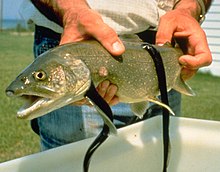
- As with the hagfish, lampreys appear eel-like in shape. They have cartilaginous skeletons and have been evolving separately from any other group for over 400 million years. They are predatory and often attach themselves to a fish or other small animal and gradually drain blood and organs. The largest species is the sea lamprey (Petromyzon marinus), which can grow to 1.2 m (3.9 ft) and weigh 2.5 kg (5.5 lb).[20]
Armored fish (Placodermi)
[edit]The largest fish of the now-extinct class Placodermi was the giant predatory Dunkleosteus. The largest and most well known species was D. terrelli, which grew almost 9 m (29.5 ft) in length[21] and 4 t (4.4 short tons)[22] in weight. Its filter feeding relative, Titanichthys, may have rivaled it in size.[23] Titanichthys reached a length of 7 m (23 ft)[24][25] though in older paper it was estimated at 7.5 m (25 ft).[26]
Cartilaginous fish (Chondrichthyes)
[edit]
The cartilaginous fish are not directly related to the "bony fish," but are sometimes lumped together for simplicity in description. The largest living cartilaginous fish, of the order Orectolobiformes, is the whale shark (Rhincodon typus), of the world's tropical oceans. It is also the largest living animal that is not a cetacean and, like the largest whales, it is a docile creature that filter-feeds on tiny plankton. An average adult of this species measures 9.7 m (32 ft) long and weighs an average of 9 tonnes. The largest verified specimen was caught in 1949 off Karachi, Pakistan and was 12.7 m (42 ft) long and weighed 21.5 tonnes (21.2 long tons; 23.7 short tons). Although many are dubious, there are several reports of larger whale sharks, with reliable sources citing unverified specimens of up to 37 tonnes (36 long tons; 41 short tons) and 17 m (56 ft).[1][27]
- Ground sharks (Carcharhiniformes)

- The largest species of this order is the widely distributed tiger shark (Galeocerdo cuvier). Specimens have been verified to at least 5.5 m (18 ft) but even larger ones have been reported. One specimen, a gravid female caught off Australia and measuring only 5.5 m (18 ft) long, weighed an exceptional 1,524 kg (3,360 lb).[1] A female caught in 1957 reportedly measured 7.4 m (24 ft) and weighing 3,110 kg (6,860 lb), although this very outsized shark is not known to have been confirmed.[28] The largest of the "requiem sharks" (in the genus Carcharhinus) seems to be the dusky shark (C. obscurus), at up to 4.2 m (14 ft) and a weight of 350 kg (770 lb).[29] However, the bulkier bull shark (C. leucas) has been estimated to weigh about 575 kg (1,268 lb) in recent specimens that measured over 4 m (13 ft) long.[30] The silky shark (C. falciformis) is another contender for the largest requiem shark at a maximum weight of 350 kg (770 lb) and a maximum length of around 3.5 m (11 ft). The largest hammerhead shark is the great hammerhead (Sphyrna mokarran), which can reach 6.1 m (20 ft) and weigh at least 500 kg (1,100 lb).[31] The most species-rich shark family, the catsharks, are fairly small-bodied. The largest, the nursehound (Scyliorhinus stellaris), can grow up to 1.7 m (5.6 ft) and a weight of at least 10.8 kg (24 lb).[32][33]
- Chimaeras (Chimaeriformes)
- These odd, often translucent cartilaginous fish are typically quite small. The largest species is the carpenter's chimaera (Chimaera lignaria) of the oceans near Australia and New Zealand. It can reach up to 1.5 m (4.9 ft) in length and weigh 15.4 kg (34 lb).[34]
- Frill sharks and cow sharks (Hexanchiformes)
- The largest frill sharks and cow shark is the Bluntnose sixgill shark (Hexanchus griseus). This large species typically inhabits depths greater than 90 m (300 ft), and has been recorded as deep as 1,875 m (6,152 ft). The largest specimen known (caught off Cuba) reportedly weighed 763 kg (1,682 lb) and measured 4.82 m (15.8 ft) long.[1]
- Bullhead sharks (Heterodontiformes)
- These tropical, small sharks are noted for their broad head shape. The largest species is the Port Jackson shark (Heterodontus portusjacksoni) of Australasian waters, at up to 1.65 m (5.4 ft) long and weighing up to 20 kg (44 lb).[35]
- Mackerel sharks (Lamniformes)

- Most species in this order grow quite large. The largest living species is the basking shark (Cetorhinus maximus) of the world's northern temperate oceans, also the second largest fish. The largest specimen, which was examined in 1851, measured 12.3 m (40 ft) long and weighed 16 tonnes.[1] Perhaps the most famous "big fish" is the great white shark (Carcharodon carcharias). Specimens have been measured up to 6.4 m (21 ft) and weighing 3,312 kg (7,302 lb), with great whites of at least 7 m (23 ft) long generally accepted.[1][36] The common thresher (Alopias vulpinus), can grow to 7.6 m (25 ft) and weigh over 510 kg (1,120 lb), but much of its length is comprised by its extreme tail.[37][38] Odd and recently discovered giants also live in this order: the slender, sword-snouted goblin shark (Mitsukurina owstoni), with unweighed specimens of up to approximately 6.17 m (20.2 ft), and the massive megamouth shark (Megachasma pelagios), up to 5.6 m (18 ft) long and a weight of 1,215 kg (2,679 lb).[39][40]
- The largest shark in the fossil record is the megalodon (Otodus megalodon), a colossal Neogene lamniform. The range of estimates of the maximum length for megalodon are from 17 to 20.3 m (56 to 67 ft), with a mass ranging from 65 to 114 short tons (59 to 103 t).[41][42][43] It is also regarded as the largest macro-predatory fish ever.
- Stingrays and allies (Myliobatiformes)
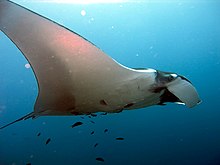
- Both the largest species of this order and the largest of all rays is the giant oceanic manta ray (Manta birostris). This peaceful leviathan can reach a size of 3,000 kg (6,600 lb), a "disk" width of 9.1 m (30 ft) and a total length of 5 m (16 ft).[44] A related species reaches barely smaller sizes, the devil fish (Mobula mobular). It can grow up to a 5.2 m (17 ft) disk width, a total length of 6.5 m (21 ft) and a weight of at least 1,000 kg (2,200 lb).[45][46] The largest stingray is generally accepted to be the short-tail stingray (Dasyatis brevicaudata), found off the southern tip of Africa and Australasia, at up to 4.3 m (14 ft) across the disk and weighing more than 350 kg (770 lb).[47] Although there are several large stingrays that at least approach this species' size. One, the giant freshwater stingray (Himantura polylepis), of the large rivers of South Asia, can weigh up to 600 kg (1,300 lb), measure up to 5 m (16 ft) in total length and have a disc span of 2.4 m (7.9 ft).[48][49]
- Carpet sharks (Orectolobiformes)
- The whale shark is the largest species in this order, reaching up to 20 meters long when fully mature.[50] No other species in the order even approaches this size. The next largest species is the nurse shark (Ginglymostoma cirratum), which can grow up to 4.3 m (14 ft) across the disk and weighing more than 350 kg (770 lb).[51]
- Sawfish (Pristiformes)
- Distinguished by a long snout decorated with sharp teeth on the sides, these little-known cartilaginous fish are often reported to attain huge sizes. The definitive largest species is not known, although the smalltooth sawfish (Pristis pectinata) and the green sawfish (P. zijsron), at up to reportedly 7.6 and 7.3 m (25 and 24 ft), respectively, may be the largest.[52][53] Weights of up to 1,955 kg (4,310 lb) have been reported, possibly for the smalltooth species, but are not verified.[54] The large-tooth sawfish (P. pristis) and freshwater sawfish (P. microdon) can both exceed 6.5 m (21 ft).[55][56]
- Sawsharks (Pristiophoriformes)
- Despite sharing a similar appearing snout adapted in both to shred fish prey, the sawsharks are typically much smaller than sawfish. The largest sawshark is the Sixgill sawshark (Pliotrema warreni) of the South Indian ocean, which can grow up to 1.7 m (5.6 ft) and weigh 15 kg (33 lb).[57]
- Skates and allies (Rajiformes)
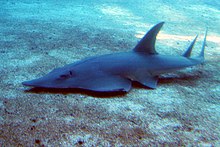
- The largest and most diverse order of rays' largest species is the giant guitarfish (Rhynchobatus djiddensis) of the Red Sea and the eastern Indian ocean. The top size of the species is 227 kg (500 lb) and 3.1 m (10 ft).[58] The largest of the skates is the common skate (Dipturus batis). This species can grow up to 2.85 m (9.4 ft) in length and weigh 97.1 kg (214 lb).[59]
- Dogfish and allies (Squaliformes)
- The largest known member of this order is the Greenland shark (Somniosus microcephalus), a giant predator of sub-Arctic waters. This species has been confirmed to as much as 6.4 m (21 ft) in length and a weight of 1,397 kg (3,080 lb), although specimens of up to 7.3 m (24 ft) have been reportedly caught.[1][60] The Pacific sleeper shark (Somniosus pacificus) has been measured only to 4.4 m (14 ft) and 888 kg (1,958 lb) in a gravid female, although specimens up to an estimated 7 m (23 ft) have been scientifically observed.[1][61] A single unconfirmed account exists of an enormous Pacific sleeper shark that potentially measured up to 9.2 m (30 ft) long.[62] The spiny dogfish (Squalus acanthias), a very common species, reaches the largest sizes of the "true dogfish" family. Specimens have been measured at up to 1.6 m (5.2 ft) and 9.1 kg (20 lb).[63]
- Angelsharks (Squatiniformes)
- The largest of the bottom-dwelling angelsharks (named for their shape rather than disposition) is the common angelshark (Squatina squatina) of the northeast Atlantic Ocean. This species can grow up to 2.4 m (7.9 ft) long and weigh up to 80 kg (180 lb).[64]
- Electric rays (Torpediniformes)
- The largest of the electric rays is Atlantic torpedo (Torpedo nobiliana). This fish can measure 1.8 m (5.9 ft) long and weigh 90 kg (200 lb).[65] However, a length of 0.6–1.5 m (2.0–4.9 ft) and weight of 30 pounds (14 kg) is more typical.[66][67] Females attain a larger size than males.[68]
Spiny sharks (Acanthodii)
[edit]The largest of the now-extinct Acanthodii was Xylacanthus grandis, an ischnacanthiform based on a ~35 cm (14 in) long jaw bone. Based on the proportions of its relative Ischnacanthus, X. grandis had an estimated total length of 2.5 m (8 ft 2 in).[69]
Bony fish (Osteichthyes)
[edit]Ray-finned fish (Actinopterygii)
[edit]
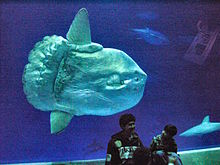

The largest living bony fish (superclass Osteichthyes, which includes both ray-finned and lobe-finned fish) are the lesser known southern sunfish (Mola alexandrini) followed by widely distributed and better known ocean sunfish (Mola mola) and, both being members of the order Tetraodontiformes. The largest verified specimen belongs to the southern sunfish discovered dead near the Azores in the Atlantic has set the record for being the largest extant bony fish with the weight of 2,744 kg (6,049 lb). The record size ocean sunfish crashed into a boat off Bird Island, Australia in 1910 and measured 4.3 m (14 ft) from fin-to-fin, 3.1 m (10 ft) in length and weighed about 2,300 kg (5,100 lb),[1] while the other record for the biggest bony fish is yet held by a Mola alexandrini which was also coincidentally 2,300 kg (5,100 lb) in mass and 3 m (9.8 ft) in length, caught off in 1996 and misidentified as a Mola mola.
As for length, the longest extant bony fish on earth is the giant oarfish (Regalecus glesne). Slender and compressed, it averages over 6 m (20 ft) long at maturity. A specimen caught in 1885 of 7.6 m (25 ft) in length weighed 275 kg (606 lb). The longest known example, which was hit by a steamship, was measured as 13.7 m (45 ft) long.[1]
Much larger bony fish existed prehistorically, the largest ever known having been Leedsichthys of the Jurassic period. This species is certainly the largest bony fish ever and perhaps the largest non-cetacean marine animal to have ever existed. Estimates of the size of this fish range from 21 to 27 m (69 to 89 ft) and mass from 20 to 50 tons. A maximum size of 22 m (72 ft) and 25–30 tons has been deemed to be most realistic.[70]
- Sturgeons and paddlefishes (Acipenseriformes)

- The largest species is the beluga sturgeon (Huso huso) of the Caspian and Black seas, the only extant bony fish to rival the massiveness of the ocean sunfish. The largest specimen considered reliable (based on remains) was caught in the Volga estuary in 1827 and measured 7.3 m (24 ft) and weighed 1,474 kg (3,250 lb).[1] The slightly smaller kaluga (Huso dauricus) or great Siberian sturgeon has been weighed reliably up to 1,140 kg (2,510 lb) (Berg, 1932) and a length of 5.6 m (18 ft).[1][71] The North American white sturgeon (Acipenser transmontanus), unverified to 907 kg (2,000 lb) and 6.1 m (20 ft), Chinese, European oceanic, and the Russian sturgeon (A. gueldenstaedtii), at as much as 1,000 kg (2,200 lb) and 5.5 m (18 ft) for a 75-year-old female, also can attain great sizes.[1] Atlantics and Baikal sturgeons are following as well. These fish are sometimes called the largest freshwater fish but sturgeons spend a great deal of time in brackish water and switch back and forth between saltwater and freshwater environments in their life cycle. Also included in this order are the paddlefish and the Chinese paddlefish (Psephurus gladius), which is now officially recognised as extinct by the IUCN (as of July 2022), is also a very large fish. Reportedly, fisherman as recently as the 1950s have caught paddlefish measuring up to 6.7 m (22 ft) in total length, although no specimen greater than 3.1 m (10 ft) has been scientifically measured. The weight of the Chinese paddlefish is reportedly 300 to 500 kg (660 to 1,100 lb).[72][73]
- Bonefish (Albuliformes)
- The largest Albuliformes is the bonefish (Albula vulpes), which weighs up to 19 lb (8.6 kg) and measures up to 90 cm (35 in) long. It is silvery in color with dusky fins. The bases of the pectoral fins are yellow.
- Bowfins (Amiiformes)
- The bowfin (Amia calva) is the sole extant member of its order. The most distinctive characteristic of the bowfin is its very long dorsal fin consisting of 145 to 250 rays, and running from mid-back to the base of the tail. The caudal fin is a single lobe, though heterocercal.[74] They can grow up to 109 centimetres (43 in) in length, and weigh 9.75 kilograms (21.5 lb).[75]
- Eels (Anguilliformes)

- The largest species of "true eel," if measured in weight and overall bulk, is the European conger (Conger conger). The maximum size of this species has been reported to 3 m (9.8 ft) and a mass of 110 kg (240 lb).[76] Several moray eels can equal or exceed the previous eel in length but do not weigh as much. The longest fish in the order, at up to 4 m (13 ft), is the slender giant moray (Strophidon sathete) of the Indo-Pacific oceans.[77]
- Silversides (Atheriniformes)
- An order best known for its tiny representatives, the largest species is the jacksmelt (Atherinopsis californiensis) of the Pacific Ocean. Although it reaches 45 cm (18 in), it is not known to even reach 450 g (0.99 lb).[78]
- Barreleyes, slickheads and argentines (Argentiniformes)
- The largest species is the greater argentine (Argentina silus), that has 76 centimetres (30 in) TL.
- The largest barreleyes are javelin spookfish (Bathylychnops exilis) found in the northern Pacific and in the eastern Atlantic Ocean near the Azores where it is found at depths of around 640 metres (2,100 ft). This species grows to a length of 50 centimetres (20 in) SL.[79]
- Jellynose fishes (Ateleopodiformes)

- Jellynose fish are benthic marine fish typically found at depths around 200 to 600 m (660 to 1,970 ft). Size ranges from 35 centimetres (14 in) (Ateleopus japonicus) to 2 meters (Guentherus altivela[80]).
- Grinners (Aulopiformes)
- The largest member of this order is the lancetfish (Alepisaurus ferox), found in all the world's oceans. Slender, with a huge spine, these fish can reach 2.1 m (6.9 ft) long and can weigh up to 11 kg (24 lb).[81]
- Toadfish (Batrachoidiformes)

- The largest toadfish is the Pacuma toadfish (Batrachoides surinamensis), reaching a size of up to 5 pounds (2.3 kg) and 23 inches (58 cm).[82]
- Flying-fish and allies (Beloniformes)
- The largest member of this order, best known for its members' ability to breach the water and glide through the sky, is the pelagic Houndfish (Tylosurus crocodilus), a slender fish at up to 1.5 m (4.9 ft) and a weight of 6.35 kg (14.0 lb).[83] The largest true "flying fish" is the Japanese flying fish (Cheilopogon pinnatibarbatus japonicus), which can range up to 0.5 m (1.6 ft) in length and weigh over 1 kg (2.2 lb).[73]
- Squirrelfish (Beryciformes)
- Best known for their highly poisonous barbs, the squirrelfish's largest representative is the giant squirrelfish (Sargocentron spiniferum) of the Indo-Pacific, at up to 51 cm (20 in) and 2.6 kg (5.7 lb).[84] The slimmer Holocentrus adscensionis from warm parts of the Atlantic can reach even greater lengths of up to 61 cm (24 in).[85]
- Whalefish (Cetomimiformes)
- Known for flesh that feels flabby to the touch, this order reaches largest sizes in the flabby whalefish (Gyrinomimus grahami) of all southern oceans. This species, which can range up to 0.45 m (1.5 ft) in length and weigh 1.5 kg (3.3 lb), is sometimes commercially fished.[73][86]
- Characins (Characiformes)
- The largest species is the African freshwater fish, the giant tigerfish (Hydrocynus goliath). The top size of this fish is 1.5 m (4.9 ft) and 50 kg (110 lb).[87][88] Among the largest of the characin family is the popular sport-fish, the golden dorado (Salminus brasiliensis), which can reach up to 1 m (3.3 ft) in length and weigh 31.4 kg (69 lb).[89] Among the characins are the infamous neotropical piranhas. Carnivorous species can grow up to 0.43 m (1.4 ft), although the Tambaqui (Colossoma macropomum), at up to 1 m (3.3 ft) and 32.4 kg (71 lb), is often considered a giant, herbivorous form of piranha.[73]
- Herring (Clupeiformes)
- The largest herring is probably the Dorab wolf herring (Chirocentrus dorab) of the Indo-Pacific oceans. The maximum size of this species has been reported as much as 1.8 m (5.9 ft), but these slender fish have never been recorded as exceeding 3.4 kg (7.5 lb) in weight.[73] The so-called "king of herrings" is not a herring, but an oarfish.
- Minnows and allies (Cypriniformes)
- The minnow family (which includes carp), Cyprinidae, is the largest family of vertebrates, with over 2400 species known today.[90] The largest species is the giant barb (Catlocarpio siamensis), which is endemic to three river basins in southeast Asia and reaches a size of as much as 3 m (9.8 ft) and a weight of as much as 300 kg (660 lb).[91] In centuries past, mahseer, specifically the golden mahseer (Tor putitora) of Southern Asia was reported to reach similar lengths, but the species has been overfished and specimens nearly as large as the giant barb have not been reported in recent centuries.[73][92]
- Pikes and allies (Esociformes)
- The largest species in this small but interesting order (formerly allied with the salmonids) is the muskellunge (Esox masquinongy) of the rivers of North America. These predatory fish can grow up to 1.8 m (5.9 ft) and 45.4 kg (100 lb).[93][94]
- Killifish and allies (Cyprinodontiformes)
- The largest species in this relatively small-bodied order is the Pacific four-eyed fish (Anableps dowei), reaching a size of 34 cm (13 in) and 588 g (1.296 lb).[95]
- Ladyfish and allies (Elopiformes)
- This small order is usually considered closely related to the true eels although its members are very different in appearance and behavior from eels. The largest species is much-coveted-sport fish, the Atlantic tarpon (Megalops atlanticus). The maximum recorded size for this species is 161 kg (355 lb) and length is up to 2.5 m (8.2 ft).[96]
- Cod (Gadiformes)

- The Atlantic cod (Gadus morhua) grows to 2 m (6.6 ft) long and 96 kg (212 lb).[97]
- Sticklebacks and allies (Gasterosteiformes)
- The largest form of stickleback, a small, cylindric type of fish, is the sea stickleback or fifteenspine stickleback (Spinachia spinachia). This species can range up to 22 cm (8.7 in) in length and weigh up to 8.5 g (0.30 oz).[73][98]
- Clingfish (Gobiesociformes)
- These bottom-dwelling fish reach their maximum size in Sicyases sanguineus. This species can reach 30 cm (12 in) in length and weigh up to 1 kg (2.2 lb).[73]
- Shellears and allies (Gonorynchiformes)
- The well-known milkfish (Chanos chanos) is the largest member of this order. The maximum size is 22.7 kg (50 lb) and 1.84 m (6.0 ft) long.[73]
- Knifefish (Gymnotiformes)
- The largest knifefish is the electric eel (Electrophorus electricus) The electric eel has an elongated, cylindrical body, typically growing to about 2 m (6 ft 7 in) in length, and 20 kg (44 lb) in weight, making it the largest species of the Gymnotiformes.[99]
- Mooneyes (Hiodontiformes)
- Only two extant species are known to exist in this relatively new order. The larger of the two is the goldeye (Hiodon alosoides) from the northern rivers of North America, which can reach up to 0.5 m (1.6 ft) in length and can weigh 1.8 kg (4.0 lb).[100][101]
- Ribbonfish and allies (Lampriformes)
- The largest member of this small but fascinating order is the aforementioned king of herrings or oarfish (Regalecus glesne), the longest extant bony fish on earth. Another interesting big fish in this order is the opah (Lampris guttatus), which as opposed to the king of herrings, is massive and has a chunky, rounded shape. Opahs can range up to 2 m (6.6 ft) in length and weigh up to 270 kg (600 lb).[102]
- Gars (Lepisosteiformes)

- The largest of the gar, and the largest entirely freshwater fish in North America, is the alligator gar (Atractosteus spatula). The largest gar ever known, caught in Louisiana in 1925, was 3 m (9.8 ft) in length and weighed 137 kg (302 lb).[1]
- Anglerfish (Lophiiformes)
- The largest of this diverse order is the common goosefish (Lophius piscatorius) found in the northeastern Atlantic off Europe and North Africa. This big-mouthed fish can attain a size of 58 kg (128 lb) and a length of 2 m (6.6 ft).[103]
- Lanternfish (Myctophiformes)
- The largest of the numerous but small lanternfish is Bolin's lanternfish (Gymnoscopelus bolini) of the Indo-Pacific oceans, at up to 249 g (8.8 oz) and 35 cm (14 in).[73]
- Mullets (Mugiliformes)
- The largest of mullets flathead mullet (Mugil cephalus) have dark centers which give the appearance of a series (6–7) of dark horizontal stripes. The fish grow to lengths up to 60.0 cm (23.6 in) with weights as high as 4.0 kg (8.8 lb).
- Pearlfish and allies (Ophidiiformes)
- The largest member of this order is the widely distributed giant cusk-eels (Lamprogrammus shcherbachevi). A cuskeel can be nearly 2 m (6.6 ft) long, but even large fish probably aren't much over 10 kg (22 lb) since they are quite slender.[73]
- Smelts and allies (Osmeriformes)
- The largest smelt is the rainbow smelt (Osmerus mordax). The body of the rainbow smelt is slender and cylindrical. When full grown, the rainbow smelt is between 7 and 9 inches (18 and 23 cm) long and weighs about 3 ounces (85 g). Individuals over 12 inches (30 cm) long are known.[104]
- Bony-tongued fish (Osteoglossiformes)
- The largest species is the South American fish usually known as the arapaima (Arapaima gigas). The maximum size this species can attain is a matter of some controversy and some rank it among the world's largest freshwater fishes. No individual arapaima over 3 m (9.8 ft) has been verified and measured. The skeleton of a fish reported to have been measured by native hunters as 4.5 m (15 ft) and weighing 200 kg (440 lb) when caught, was later examined as a skeleton scientifically and was found to have been roughly within that outsized dimension.[1]
- Perches and allies (Perciformes)[dubious – discuss]
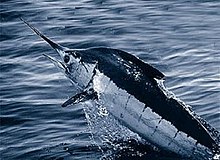
- The title of the largest member of this order, the most numerous order of all vertebrates, is a matter of some debate. A large marlin is the biggest of these fishes: the black marlin (Makaira indica) of the Indo-Pacific, the Atlantic blue marlin (Makaira nigricans) and the Indo-Pacific blue marlin (Makaira mazara). All of these similarly sized species can exceptionally reach up to 5 m (16 ft) in length and weight may be as much as 907 kg (2,000 lb) or even 1,106 kg (2,438 lb).[73][105][106] Another notable giant of the perch order is the Atlantic bluefin tuna (Thunnus thynnus) of the Northern Atlantic ocean, which has been verified at up to 4.4 m (14 ft) and 679 kg (1,497 lb), although can reportedly reach 910 kg (2,010 lb).[107][108] The swordfish (Xiphias gladius) can reach a maximum weight of 650 kg (1,430 lb) and length of 4.5 m (15 ft).[109] Due to heavy fishing of both species, swordfish and tuna of great sizes are increasingly rare. One of the largest freshwater fishes is the Nile perch (Lates niloticus), which grows up to 200 kg (440 lb) and 2 m (6.6 ft).[110] The biggest of snappers is the Cubera snapper (Lutjanus cyanopterus) of the Caribbean sea and east coast of South America, at a maximum size of 57 kg (126 lb) and 1.6 m (5.2 ft) in length.[111][112] The largest species of grunt is the white margate (Haemulon album) of the Caribbean sea and east coast of South America, at up to 7.14 kg (15.7 lb) and 0.8 m (2.6 ft) in length.[113][114] The blennies can range up to 0.55 m (1.8 ft) in the hairtail blenny (Xiphasia setifer) of the Indo-Pacific.[73] The jacks or mackerels reach their maximum size in the Chinese seerfish (Scomberomorus sinensis), which can attain 131 kg (289 lb) and 2.47 m (8.1 ft).[115] The largest butterflyfish are either the lined butterflyfish (Chaetodon lineolatus) or the saddle butterflyfish (C. ephippium), both of the Indo-Pacific and both of which can measure up to 30 cm (12 in).[116] The freckled darter (Percina lenticula) of the United States, the biggest of the darters, reaching 20 cm (7.9 in) and 70 g (2.5 oz).[117][118] The largest drum is the Totoaba (Totoaba macdonaldi) of the Gulf of California, at up to 100 kg (220 lb) and 2 m (6.6 ft) long.[119] Among the sea bass or groupers, many of which can grow quite large, the greatest size are reached in the Atlantic goliath grouper (Epinephelus itajara) and the giant grouper (Epinephelus lanceolatus). Both can reach a maximum known length of 2.5 m (8.2 ft) and weight of 455 kg (1,003 lb) and 600 kg (1,300 lb) respectively.[120][121] The species-rich cichlids reach their maximum size in the East African giant cichlid (Boulengerochromis microlepis), at up to 0.8 m (2.6 ft) long and 5 kg (11 lb).[122] The humphead wrasse (Cheilinus undulatus) of the Indo-Pacific's coral reefs is by far the largest wrasse, and it can reach a maximum size of 191 kg (421 lb) and 2.3 m (7.5 ft).[123] Among a fairly small-bodied family, the damselfishes, the Garibaldi (Hypsypops rubicundus) of the Pacific coast of America is the biggest, reaching up to 35.5 cm (14.0 in) and 1.2 kg (2.6 lb).[124] The marbled sleeper (Oxyeleotris marmorata) of East Asia is the largest member of the family or sub-order that almost certain contains the smallest living vertebrate, and can reach 0.66 m (2.2 ft) long and weigh 9.9 kg (22 lb).[73][125]
- Trout-perch and allies (Percopsiformes)
- The largest species in this small order (both by number of species and body size) is the sand roller (Percopsis transmontana) of North America. This species can range up to 20 cm (7.9 in) in length and can weigh over 11 g (0.39 oz).[73]
- Flatfish (Pleuronectiformes)
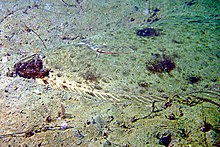
- The largest of the well-known and heavily fished flatfish is the Pacific halibut (Hippoglossus stenolepis). This giant can reach 363 kg (800 lb) and 3 m (9.8 ft), although fish even approaching this size would be extraordinary these days.[126] The Atlantic halibut (Hippoglossus hippoglossus) is also sometimes titled the largest flatfish, although it has a slightly smaller maximum size, at 320 kg (710 lb) and 2.8 m (9.2 ft).[73][127]
- Beardfish (Polymixiiformes)
- The little-known beardfish are sometimes classified with the Beryciformes. The largest beardfish is Polymixia busakhini of the Indo-Pacific, which can range up to 0.6 m (2.0 ft) in length.[73]
- Polypterids and allies (Polypteriformes)
- The largest polypterid is Polypterus congicus, which reaches up to 97 cm (38 in) in length.[128]
- Gulper eels (Saccopharyngiformes)
- The largest gulper eel is the pelican eel (Eurypharynx pelecanoides). The pelican eel grows to about 1 m (3.3 ft) in length.
- Salmon and allies (Salmoniformes)

- The largest species of salmonid is the taimen (Hucho taimen). The biggest recorded taimen was caught in the Kotui River in Russia, and measured 2.1 m (6.9 ft) and weighed 105 kg (231 lb).[129] Some sources claim the largest is the Chinook salmon (Oncorhynchus tshawytscha) of America's Pacific Northwest, although this species falls behind the taimen in maximum size.[73] The maximum size of this fish is 61.4 kg (135 lb) and 1.5 m (4.9 ft) long.[130]
- Sculpins (Scorpaeniformes)
- Although less venomous than many smaller fish in the same order, the skilfish (Erilepis zonifer) of the North Pacific, is largest sculpin. The maximum size is 1.9 m (6.2 ft) and the weight can be up to 91 kg (201 lb).[131] The Lingcod (Ophiodon elongatus) of the west coast of North America is sometimes listed as the largest sculpin but it is not known to exceed 1.5 m (4.9 ft) in length or 60 kg (130 lb) in weight.[73][132] The Cottidae can range up to 0.7 m (2.3 ft) and 11 kg (24 lb) in the cabezon (Scorpaenicthys marmoratus) of coastal North America.[73]
- Catfish (Siluriformes)

- Most authorities now give the crown of the largest catfish to the Mekong giant catfish, Pangasianodon gigas, which is also considered the heaviest completely freshwater fish.[1] This fish has been recorded at sizes up to 350 kg (770 lb) and 3 m (9.8 ft).[133][134][135][136] The closely-related Asian giant pangasius (Pangasius sanitwongsei) can grow to 3 m (9.8 ft) and 300 kg (660 lb).[137] Another large species is the wels catfish (Silurus glanis) of Europe and Central Asia, which strongly rivals the proceeding species in weight and could possibly surpass them in length. While wels have been confirmed to 3.1 m (10 ft), other whiskered giants have been reliably reported to grow to 3.7 m (12 ft) and 265 kg (584 lb) and less reliably to 4.3 m (14 ft).[1] In South America there also exists the Brachyplatystoma filamentosum, which can reportedly reach up to 3.6 m (12 ft) and 200 kg (440 lb).[138]
- Ridgeheads and allies (Stephanoberyciformes)
- The largest ridgeheads Poromitra curilensis, a Pacific ridgehead related to the crested bigscale,[139] at up to 18 centimetres standard length (SL; a measurement excluding the caudal fin).[140] Most ridgeheads are well under 10 centimetres SL.
- Bristlemouths (Stomiiformes)

- The largest of the deep-sea bristlemouths is the short-tailed barbeled dragonfish (Oppostomias micripnus). The top size of a female of this species is probably over 452 g (0.996 lb) and 50 cm (20 in) long.[73] In species like the barbeled dragonfish (Idiacanthus atlanticus), the snake-like females can measure up to 0.5 m (1.6 ft) long, about 50 times as long as the male.[141] Although Idiacanthus is much more slender and is lighter than Oppostomias.[73]
- Swamp-eels (Synbranchiformes)
- The tropic-dwelling swamp-eels, which are not closely related to true eels, reaches their largest size in the marbled swamp eel (Synbrachus marmoratus) of Central and South America. This fish can range up to 1.5 m (4.9 ft) and weigh 7 kg (15 lb).[73]
- Seahorses and allies (Syngnathiformes)
- The largest of this diverse order is the red cornetfish (Fistularia petimba), a long, thin species found in all tropical oceans. This fish can reach a length of 2 m (6.6 ft) and a weight of 4.65 kg (10.3 lb).[73] The largest of the famous, petite seahorses is the big-belly seahorse (Hippocampus abdominalis) found off Australia and New Zealand, which can grow to 35 cm (14 in) high and weigh over 60 g (2.1 oz).[142]
- Pufferfishes and allies (Tetraodontiformes)
- The starry pufferfish Arothron stellatus is the largest pufferfish in the world, growing to a length of 48 in (120 cm). The largest freshwater pufferfish is the mbu pufferfish (Tetraodon mbu) from the Congo River basin. It attains lengths of 67 cm (26 in). As such, these fish are difficult to adequately house in captivity since they require a very large aquarium and appropriately scaled water filtration. At lengths up to 1 m (39 in), the stone triggerfish ("Pseudobalistes naufragium") from the eastern Pacific is the largest triggerfish, edging out the titan triggerfish (Balistoides viridescens).[143]
- Dories (Zeiformes)
- The largest species of dory is the Cape dory (Zeus capensis) reaching a size of 90 cm (35 in) and a weight of 20 kg (44 lb).[73][144]
Lobe-finned fish (Sarcopterygii)
[edit]
The largest living (non-tetrapod) lobe-finned fish is the coelacanth. The average weight of the living West Indian Ocean coelacanth, (Latimeria chalumnae), is 80 kg (180 lb), and they can reach up to 2 m (6.6 ft) in length. Specimens can weigh up to 110 kg (240 lb). The largest lobe-finned fish of all time was Rhizodus at up to 7 m (23 ft).[145]
- Lungfish (Dipnoi)
- The largest lungfish, the African lungfish (Protopterus aethiopicus), is smooth, elongated, and cylindrical with deeply embedded scales. The tail is very long and tapers at the end. They can reach a length of up to 2 m (6.6 ft) and may weigh as much as 50 kg (110 lb).[146][147] The pectoral and pelvic fins are also very long and thin, almost spaghetti-like.
See also
[edit]References
[edit]- ^ a b c d e f g h i j k l m n o p q r s t u v w x Wood, Gerald L. (1983). The Guinness Book of Animal Facts and Feats. ISBN 978-0-85112-235-9.
- ^ "Whale Shark". Georgia Aquarium. Retrieved 2021-10-10.
- ^ Collett, Robert (1905). Meddelelser om Norges Fiske i Aarene 1884–1901 (3die Hoved-Supplement til "Norges Fiske", III Slutning). Forhandlinger i Videnskabs–selskabet i Christiania.
- ^ Coles, R.J. (1915). "Notes on the sharks and rays of Cape Lookout, N. C". Proceedings of the Biological Society of Washington. 28: 89–94.
- ^ Tricas, T. C.; McCosker, J. E. (12 July 1984). "Predatory behaviour of the white shark (Carcharodon carcharias), with notes on its biology". Proceedings of the California Academy of Sciences. 43 (14). California Academy of Sciences: 221–238.
- ^ Froese, Rainer; Pauly, Daniel (eds.). "Carcharodon carcharias". FishBase. August 2024 version.
- ^ Meyer, Carl G.; O'Malley, Joseph M.; Papastamatiou, Yannis P.; Dale, Jonathan J.; Hutchinson, Melanie R.; Anderson, James M.; Royer, Mark A.; Holland, Kim N. (2014). "Growth and Maximum Size of Tiger Sharks (Galeocerdo cuvier) in Hawaii". PLOS ONE. 9 (1): e84799. Bibcode:2014PLoSO...984799M. doi:10.1371/journal.pone.0084799. PMC 3885620. PMID 24416287.
- ^ Deborah Nuzzolo (December 2010). Tiger Shark. Shark Zone. ISBN 978-1429654159.
- ^ Froese, Rainer; Pauly, Daniel (eds.). "Galeocerdo cuvier". FishBase. October 2021 version.
- ^ a b Froese, Rainer; Pauly, Daniel (eds.). "Mobula birostris". FishBase. August 2024 version.
- ^ "One of biggest great white sharks seen feasting on sperm whale in rare video". National Geographic Society. 19 July 2019. Archived from the original on March 3, 2021.
- ^ "Short Sunfish (Mola ramsayi)". iNaturalist.org.
- ^ Froese, Rainer; Pauly, Daniel (eds.). "Huso huso". FishBase. August 2024 version.
- ^ "A Beluga (Sturgeon) caught in 1922 - Our Planet". ourplnt.com. 14 July 2017.
- ^ a b Froese, Rainer; Pauly, Daniel (eds.). "Masturus lanceolatus". FishBase. February 2015 version.
- ^ a b "Reef manta ray videos, photos and facts - Manta alfredi". Arkive. Archived from the original on 2017-12-10. Retrieved 2017-12-10.
- ^ Froese, Rainer; Pauly, Daniel (eds.). "Somniosus microcephalus". FishBase. August 2024 version.
- ^ a b "Megamouth shark washes up in Philippines and is only the 60th we've ever seen". wordpress.com. 28 January 2015.
- ^ Froese, Rainer; Pauly, Daniel (eds.). "Eptatretus goliath". FishBase. August 2024 version.
- ^ Froese, Rainer; Pauly, Daniel (eds.). "Petromyzon marinus". FishBase. August 2024 version.
- ^ Ferrón, Humberto G.; Martínez-Pérez, Carlos; Botella, Héctor (6 December 2017). "Ecomorphological inferences in early vertebrates: reconstructing Dunkleosteus terrelli (Arthrodira, Placodermi) caudal fin from palaeoecological data". PeerJ. 5: e4081. doi:10.7717/peerj.4081. ISSN 2167-8359. PMC 5723140. PMID 29230354.
- ^ "Ancient Predator Had Strongest Bite Of Any Fish, Rivaling Bite Of Large Alligators And T. Rex". ScienceDaily. 29 November 2006. Retrieved 7 September 2022.
- ^ Gilbert Powell Larwood, Paul D. Taylor (1990). Major Evolutionary Radiations. Systematics Association. p. 310. ISBN 9780198577188. Retrieved 2022-08-28.
- ^ Bulletin 70. Ohio. Division of Geological Survey. 1996. p. 290. ISBN 9780931079054. Retrieved 2022-08-28.
- ^ Underwood, Charlie; Richter, Martha; Johanson, Zerina, eds. (2019). Evolution and Development of Fishes. Cambridge University Press. p. 13. ISBN 9781107179448. Retrieved 31 August 2022.
- ^ Bashford Dean (1895). Fishes, Living and Fossil: An Outline of Their Forms and Probable Relationships. Macmillan and Company. p. 130. ISBN 978-1-02-238982-3. Retrieved 2022-08-28.
- ^ "Summary of Large Whale Shark Rhincodon typus Smith, 1828". Homepage.mac.com. [dead link]
- ^ Large tiger sharks Archived 2012-04-10 at the Wayback Machine. Homepage.mac.com
- ^ Froese, Rainer; Pauly, Daniel (eds.). "Carcharhinus obscurus". FishBase. August 2012 version.
- ^ Summary of Large Bull Shark Carcharhinus leucas (Valenciennes, 1839) Archived 2012-01-20 at the Wayback Machine. Homepage.mac.com
- ^ Great hammerhead videos, photos and facts – Sphyrna mokarran Archived 2013-12-22 at the Wayback Machine. ARKive
- ^ Froese, Rainer; Pauly, Daniel (eds.). "Scyliorhinus stellaris". FishBase. August 2024 version.
- ^ "Irish Specimen Fish Committee". Irish-trophy-fish.com. ISFC. Archived from the original on 2011-03-18.
- ^ Chimaera lignaria (Carpenter’s Chimaera, Giant Chimaera, Giant Purple Chimaera). Iucnredlist.org
- ^ Froese, Rainer; Pauly, Daniel (eds.). "Heterodontus portusjacksoni". FishBase. August 2024 version.
- ^ Froese, Rainer; Pauly, Daniel (eds.). "Carcharodon carcharias". FishBase. August 2024 version. 751.
- ^ Froese, Rainer; Pauly, Daniel (eds.). "Alopias vulpinus". FishBase. August 2024 version.
- ^ "Monster 16ft shark sold for £255". BBC News. 2007-11-22.
- ^ Goblin Sharks, Mitsukurina owstoni Jordan 1898 Archived 2012-03-05 at the Wayback Machine. Homepage.mac.com
- ^ FLMNH Ichthyology Department: Megamouth. Flmnh.ufl.edu (2010-11-06)
- ^ Klimley, Peter; Ainley, David (1996). Great White Sharks: The Biology of Carcharodon carcharias. Academic Press. ISBN 978-0-12-415031-7.
- ^ Pimiento, Catalina; Dana J. Ehret; Bruce J. MacFadden; Gordon Hubbell (May 10, 2010). Stepanova, Anna (ed.). "Ancient Nursery Area for the Extinct Giant Shark Megalodon from the Miocene of Panama". PLOS ONE. 5 (5): e10552. Bibcode:2010PLoSO...510552P. doi:10.1371/journal.pone.0010552. PMC 2866656. PMID 20479893.
- ^ Wroe, S.; Huber, D. R.; Lowry, M.; McHenry, C.; Moreno, K.; Clausen, P.; Ferrara, T. L.; Cunningham, E.; Dean, M. N.; Summers, A. P. (2008). "Three-dimensional computer analysis of white shark jaw mechanics: how hard can a great white bite?". Journal of Zoology. 276 (4): 336–342. doi:10.1111/j.1469-7998.2008.00494.x.
- ^ Froese, Rainer; Pauly, Daniel (eds.). "Mobula birostris". FishBase. August 2024 version.
- ^ "Giant devilray videos, photos and facts – Mobula mobular". ARKive. Archived from the original on 2013-11-10.
- ^ "First documented catch of the giant devil ray Mobula mobular". Docstoc.com.
- ^ "Smooth Stingray, Dasyatis brevicaudata (Hutton, 1875)". Australian Museum. 2011-10-20.
- ^ Froese, Rainer; Pauly, Daniel (eds.). "Urogymnus polylepis". FishBase. August 2024 version.
- ^ "Giant freshwater stingray videos, photos and facts - Himantura chaophraya". Archived from the original on 2013-12-24.
- ^ "Whale Shark | Species | WWF". World Wildlife Fund. Retrieved 2021-11-02.
- ^ Nurse Sharks – Nurse Shark Pictures – Nurse Shark Facts. Animals.nationalgeographic.com
- ^ Froese, Rainer; Pauly, Daniel (eds.). "Pristis pectinata". FishBase. August 2024 version. 2057.
- ^ Froese, Rainer; Pauly, Daniel (eds.). "Pristis zijsron". FishBase. August 2024 version. 7956.
- ^ "Big Fish Stories". Elasmo-research.org.
- ^ "Largetooth Sawfish". Flmnh.ufl.edu. FLMNH Ichthyology Department. Archived from the original on 2014-01-09. Retrieved 2003-04-01.
- ^ Froese, Rainer; Pauly, Daniel (eds.). "Pristis microdon". FishBase. August 2024 version. 2546.
- ^ Froese, Rainer; Pauly, Daniel (eds.). "Pliotrema warreni". FishBase. August 2024 version.
- ^ Froese, Rainer; Pauly, Daniel (eds.). "Rhynchobatus djiddensis". FishBase. August 2024 version.
- ^ Froese, Rainer; Pauly, Daniel (eds.). "Dipturus batis". FishBase. August 2024 version.
- ^ Froese, Rainer; Pauly, Daniel (eds.). "Somniosus microcephalus". FishBase. August 2024 version.
- ^ Castro, José I., The Sharks of North America. Oxford University Press (2011), ISBN 978-0-19-539294-4
- ^ The New World of the Oceans: Men and Oceanography
- ^ Froese, Rainer; Pauly, Daniel (eds.). "Squalus acanthias". FishBase. August 2024 version.
- ^ Froese, Rainer; Pauly, Daniel (eds.). "Squatina squatina". FishBase. August 2024 version.
- ^ Burton, R. (2002). International Wildlife Encyclopedia (third ed.). Marshall Cavendish. p. 768. ISBN 978-0-7614-7266-7.
- ^ Bigelow, H.B. & W.C. Schroeder (1953). Fishes of the Western North Atlantic, Part 2. Sears Foundation for Marine Research, Yale University. pp. 80–104.
- ^ Bester, C. "Biological Profiles: Atlantic Torpedo". Florida Museum of Natural History Ichthyology Department. Retrieved November 30, 2009.
- ^ Capapé, C., O. Guélorget, Y. Vergne, J.P. Quignard, M.M. Ben Amor and M.N. Bradai (2006). "Biological observations on the black torpedo, Torpedo nobiliana Bonaparte 1835 Chondrichthyes: Torpedinidae, from two Mediterranean areas" (PDF). Annales Series Historia Naturalis Koper. 16 (1): 19–28. Archived from the original (PDF) on 2013-11-10.
{{cite journal}}: CS1 maint: multiple names: authors list (link) - ^ Ørvig, Tor (1967). "Some new acanthodian material from the Lower Devonian of Europe". Journal of the Linnean Society of London, Zoology. 47 (311): 131–153. doi:10.1111/j.1096-3642.1967.tb01400.x.
- ^ "Biggest Fish Ever Found" Unearthed in U.K. News.nationalgeographic.com (2010-10-28)
- ^ Froese, Rainer; Pauly, Daniel (eds.). "Huso dauricus". FishBase. August 2024 version.
- ^ Froese, Rainer; Pauly, Daniel (eds.). "Psephurus gladius". FishBase. August 2024 version.
- ^ a b c d e f g h i j k l m n o p q r s t u v w x y John R. Paxton; William N. Eschmeyer, eds. (1998). Encyclopedia of Fishes (Second ed.). Academic Press. ISBN 978-0-12-547665-2.
- ^ Nelson, Joseph S. (2006). Fishes of the World. John Wiley & Sons, Inc. ISBN 0-471-25031-7
- ^ Froese, Rainer; Pauly, Daniel (eds.). "Family Amiidae". FishBase. January 2009 version.
- ^ Froese, Rainer; Pauly, Daniel (eds.). "Conger conger". FishBase. August 2024 version.
- ^ Froese, Rainer; Pauly, Daniel (eds.). "Strophidon sathete". FishBase. November 2012 version. 8595.
- ^ Froese, Rainer; Pauly, Daniel (eds.). "Atherinopsis californiensis". FishBase. August 2024 version.
- ^ Froese, Rainer; Pauly, Daniel (eds.). "Bathylychnops exilis". FishBase. February 2012 version.
- ^ Froese, Rainer; Pauly, Daniel (eds.). "Guentherus altivela". FishBase. August 2024 version.
- ^ Romanov, E. V.; Zamorov, V. V. (1998). "Some biological features of longnose lancetfish Alepisaurus ferox (Alepisauridae) from the Western Indian Ocean". Mendeley.com.
- ^ Froese, Rainer; Pauly, Daniel (eds.). "Batrachoides surinamensis". FishBase. August 2024 version.
- ^ Froese, Rainer; Pauly, Daniel (eds.). "Tylosurus crocodilus crocodilus". FishBase. August 2024 version.
- ^ Froese, Rainer; Pauly, Daniel (eds.). "Sargocentron spiniferum". FishBase. March 2015 version.
- ^ Froese, Rainer; Pauly, Daniel (eds.). "Holocentrus adscensionis". FishBase. March 2015 version.
- ^ Sutton, T. T.; Porteiro, F. M.; Heino, M.; Byrkjedal, I.; Langhelle, G.; Anderson, C. I. H.; Horne, J.; Søiland, H.; Falkenhaug, T.; Godø, O. R.; Bergstad, O. A. (2008). "Vertical structure, biomass and topographic association of deep-pelagic fishes in relation to a mid-ocean ridge system" (PDF). Deep-Sea Research Part II: Topical Studies in Oceanography. 55 (1–2): 161–184. Bibcode:2008DSRII..55..161S. doi:10.1016/j.dsr2.2007.09.013.
- ^ "Tigerfish, giant (Hydrocynus goliath)". IGFA.
- ^ Froese, Rainer; Pauly, Daniel (eds.). "Hydrocynus goliath". FishBase. August 2024 version.
- ^ Froese, Rainer; Pauly, Daniel (eds.). "Salminus brasiliensis". FishBase. August 2024 version. 56329.
- ^ November pg6.htm How to Identify Fish Families[permanent dead link]. Brooklynaquariumsociety.org (December 2002)
- ^ Froese, Rainer; Pauly, Daniel (eds.). "Catlocarpio siamensis". FishBase. August 2024 version.
- ^ Froese, Rainer; Pauly, Daniel (eds.). "Tor putitora". FishBase. September 2017 version.
- ^ R. O. Anderson; R. M. Neumann (1996). B.E. Murphy; D.W. Willis (eds.). Length, Weight, and Associated Structural Indices, in Fisheries Techniques (second ed.). American Fisheries Society.
- ^ Froese, Rainer; Pauly, Daniel (eds.). "Esox masquinongy". FishBase. August 2024 version.
- ^ Froese, Rainer; Pauly, Daniel (eds.). "Anableps dowei". FishBase. August 2024 version. 12295.
- ^ Froese, Rainer; Pauly, Daniel (eds.). "Megalops atlanticus". FishBase. August 2024 version.
- ^ Froese, Rainer; Pauly, Daniel (eds.). "Gadus morhua". FishBase. August 2024 version.
- ^ Froese, Rainer; Pauly, Daniel (eds.). "Spinachia spinachia". FishBase. November 2013 version.
- ^ Albert, J.S. (2001). "Species diversity and phylogenetic systematics of American knifefishes (Gymnotiformes, Teleostei)". Misc. Publ. (190): 1–127. hdl:2027.42/56433.
- ^ Froese, Rainer; Pauly, Daniel (eds.). "Family Hiodontidae". FishBase. August 2024 version.
- ^ Ross, Stephen T. (2002). Inland Fishes of Mississippi. University Press of Mississippi. ISBN 978-1-57806-246-1.
- ^ Froese, Rainer; Pauly, Daniel (eds.). "Lampris guttatus". FishBase. August 2024 version.
- ^ Froese, Rainer; Pauly, Daniel (eds.). "Lophius piscatorius". FishBase. August 2024 version.
- ^ Froese, Rainer; Pauly, Daniel (eds.). "Osmerus mordax". FishBase. June 2006 version.
- ^ Froese, Rainer; Pauly, Daniel (eds.). "Makaira mazara". FishBase. August 2024 version.
- ^ The Biggest Fish I Ever Saw Archived 2013-11-10 at the Wayback Machine. Marlin Magazine (2007-03-27)
- ^ Burnie D and Wilson DE (Eds.), Animal: The Definitive Visual Guide to the World's Wildlife. DK Adult (2005), ISBN 0789477645
- ^ James R. Chambers. Largest Bluefin Tuna – All-Tackle IGFA World Record. Bigmarinefish.com (2010-05-24)
- ^ Froese, Rainer; Pauly, Daniel (eds.). "Xiphias gladius". FishBase. August 2024 version.
- ^ Froese, Rainer; Pauly, Daniel (eds.). "Lates niloticus". FishBase. August 2024 version.
- ^ Lee County Fishing Guides in One Place! Find Them All Here! Fishsanibel.com
- ^ Froese, Rainer; Pauly, Daniel (eds.). "Lutjanus cyanopterus". FishBase. August 2024 version.
- ^ Froese, Rainer; Pauly, Daniel (eds.). "Haemulon album". FishBase. August 2024 version.
- ^ Grunts, Fish Species – Your Fish Identification and Fishing Field Guide. Theoutdoorlodge.com
- ^ Froese, Rainer; Pauly, Daniel (eds.). "Scomberomorus sinensis". FishBase. August 2024 version.
- ^ Froese, Rainer; Pauly, Daniel (eds.). "Chaetodon ephippium". FishBase. August 2024 version.
- ^ Freeman, B. J.; Wenger, S. J. (November 2006). "Description and Distribution of Species Covered by the Etowah HCP" (PDF). UGA River Basin Center. Archived from the original (PDF) on 2013-11-10.
- ^ Craig, John (2000). Percid Fishes: Systematics, Ecology and Exploitation (Fish and Aquatic Resources). Wiley-Blackwell. ISBN 978-0-632-05616-3.
- ^ Froese, Rainer; Pauly, Daniel (eds.). "Totoaba macdonaldi". FishBase. August 2024 version.
- ^ Froese, Rainer; Pauly, Daniel (eds.). "Epinephelus itajara". FishBase. August 2024 version.
- ^ "A to Z of Oz Marine Life".
- ^ "The 10 biggest cichlids". Practical Fishkeeping. Archived from the original on 2013-11-10.
- ^ "Facts Humphead wrasse videos, photos and facts – Cheilinus undulatus". Archived from the original on 2013-11-10.
- ^ "The Biogeography of the Garibaldi (Hypsypops rubicundus)". Bss.sfsu.edu. Archived from the original on 2012-03-31.
- ^ "Oxyeleotris marmorata". Fishing-worldrecords.com. Archived from the original on 2011-11-22.
- ^ Froese, Rainer; Pauly, Daniel (eds.). "Hippoglossus stenolepis". FishBase. August 2024 version.
- ^ Froese, Rainer; Pauly, Daniel (eds.). "Hippoglossus hippoglossus". FishBase. August 2024 version.
- ^ Froese, Rainer; Pauly, Daniel (eds.). "Species in genus Polypterus". FishBase. September 2017 version.
- ^ Holcik, J.; Hensel, K.; Nieslanik, J.; L. Skacel (1988). Dr. W. Junk (ed.). The Eurasion Huchen, Hucho hucho: largest salmon of the world. Dordrecht, Netherlands: Kluwer. ISBN 9061936438.
- ^ Froese, Rainer; Pauly, Daniel (eds.). "Oncorhynchus tshawytscha". FishBase. August 2024 version.
- ^ Froese, Rainer; Pauly, Daniel (eds.). "Erilepis zonifer". FishBase. August 2024 version.
- ^ Froese, Rainer; Pauly, Daniel (eds.). "Orthonopias triacis". FishBase. August 2024 version.
- ^ "Grizzly Bear-Size Catfish Caught in Thailand". National Geographic News. Archived from the original on 2005-06-30.
- ^ "Fish whopper: 646 pounds a freshwater record". NBC News. 2005-07-01.
- ^ Seth Mydans (2005-08-24). "Hunt for the big fish becomes a race". International Herald Tribune. Archived from the original on 2009-05-01.
- ^ Froese, Rainer; Pauly, Daniel (eds.). "Pangasianodon gigas". FishBase. August 2024 version.
- ^ Froese, Rainer; Pauly, Daniel (eds.). "Pangasius sanitwongsei". FishBase. August 2024 version.
- ^ Froese, Rainer; Pauly, Daniel (eds.). "Brachyplatystoma filamentosum". FishBase. August 2024 version.
- ^ Kotlyar, A.N. (September 2008). "Revision of the genus Poromitra (Melamphaidae): Part 2. New species of the group P. crassiceps". Journal of Ichthyology. 48 (8): 553–564. Bibcode:2008JIch...48..553K. doi:10.1134/S0032945208080018. S2CID 23057815.
- ^ Parin, Nikolay V.; Ebeling, Alfred W. (February 1980). "A new Western Pacific Poromitra (Pisces: Melamphaidae)". Copeia. 1980 (1): 87–93. doi:10.2307/1444136. JSTOR 1444136.
- ^ Froese, Rainer; Pauly, Daniel (eds.). "Idiacanthus atlanticus". FishBase. August 2024 version.
- ^ Will Wooten. Seahorse Quick ID Guide. seahorse.org (2004-01-26)
- ^ Froese, Rainer; Pauly, Daniel (eds.). "Balistoides viridescens". FishBase. January 2010 version.
- ^ Froese, Rainer; Pauly, Daniel (eds.). "Zeus capensis". FishBase. August 2024 version.
- ^ NOVA. Transcripts. The Missing Link. PBS (2002-02-26)
- ^ Froese, Rainer; Pauly, Daniel (eds.). "Family Lepidosirenidae". FishBase. January 2009 version.
- ^ Protopterus aethiopicus Archived 2011-08-03 at the Wayback Machine. Fishing-worldrecords.com
